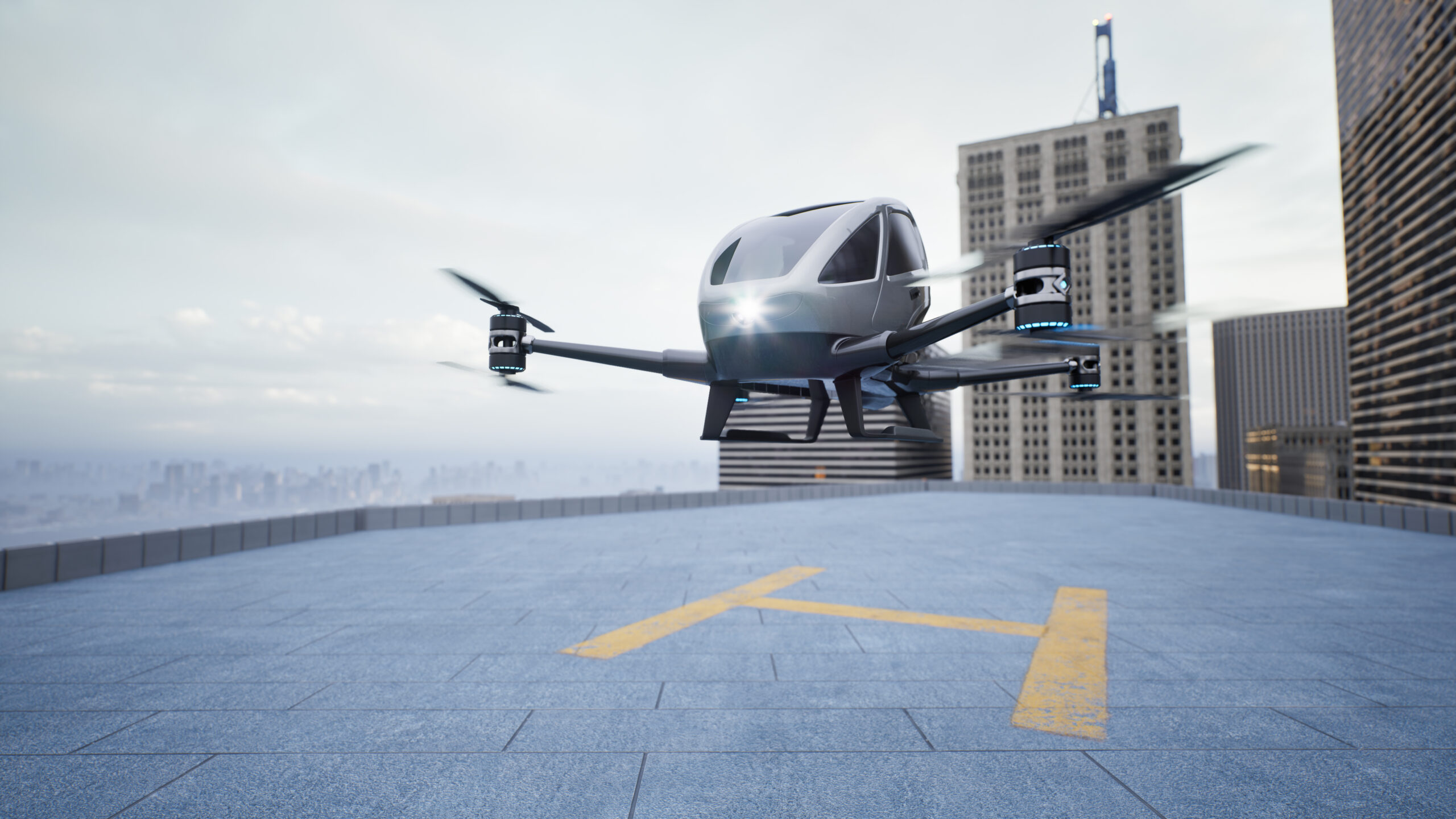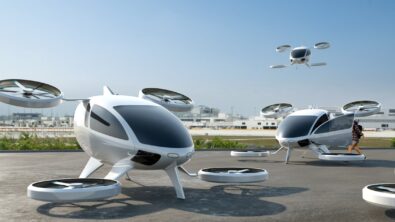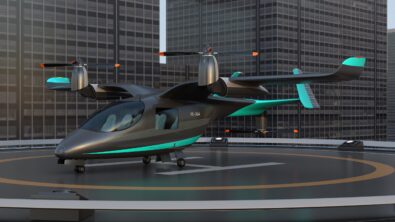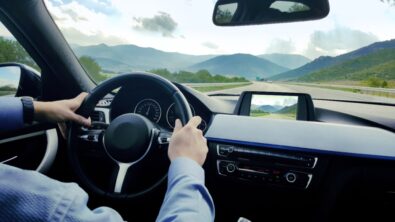Building George Jetson’s Car Part Two – Transcript

In this episode of Talking Aerospace Today, Todd Tuthill continues his introduction of advanced air mobility (AAM), reiterating the key challenges of the sector and how digital transformation can aid in AAM’s development.
Patty Russo: Greetings and welcome to Talking Aerospace Today from Siemens Digital Industries Software. I’m Patty Russo, and I manage global marketing for our aerospace and defense vertical here at Siemens. To recap, in our last episode, we kicked off a new arc covering advanced air mobility, or AAM. Todd Tuthill, our Vice President of Aerospace and Defense here at Siemens, covered the definition of AAM and identified four key challenges that companies in our sector would be facing if they endeavor to produce and develop AAMs. Before diving into today’s discussion, let’s listen to what Todd had said in the previous episode to remind ourselves what those four key challenges are.
Todd Tuthill: Okay, so design or challenges in design I think is what you’re asking me. I’ll talk about four. Okay, let’s talk about autonomy, range, infrastructure, and certification. We’ll talk about them in that order. So it, as I said before, we’ve got the company Wisk. Their Gen 6 aircraft, that they said should be certified by the end of the decade, certified by the FAA to carry paying passengers, that is fully autonomous from the beginning.
Todd Tuthill: So imagine that. Just like, you know, that car I saw in Phoenix was autonomous and passengers got in and drove them around without a driver, Wisk is saying by the end of the decade they’re going to have an autonomous Gen 6 version of the aircraft that will fly, pick you up, take you where you want to go without a pilot in it, and there’s real technological challenges to be overcome from a safety standpoint. Especially what does it take, what kind of redundancies does it take to do that?
Todd Tuthill: And I heard the CEO of Wisk on a podcast recently. He was talking about this whole idea of command and control. If you think about most of, let’s say for instance, the DJI drone I have behind me right now. I have a controller and while I’m not flying it in terms of giving it all the commands, I’m constantly commanding it telling it where to go and if the connection to the controller is lost, my TJI drone has no idea where to go. It’ll eventually, you know, it could run out of battery power and crash. Well if you’re going to put people in an aircraft like that, that’s unacceptable.
Todd Tuthill: So one of the key technologies is not just the autonomous nature of flying the aircraft around, but the safety nature of what happens when that command and control link fails. And there’s all kinds of interesting technologies and interesting challenges that need to be taken care of to overcome autonomy and also just a social aspect, of convincing people to get into an aircraft without a pilot. And Wisk has incredible technology and innovative ways that they’re solving those problems.
Todd Tuthill: So thing one is autonomy. Thing two is range. Most of the AAMs that we’re talking about right now are limited to 100 miles or less and that’s because of something called the energy density of batteries. These AAM’s are all electric. They’ve all got to carry batteries on board and there’s a limit to the size that you want to make these aircraft and how much these aircraft we want to weigh in terms of performance
Todd Tuthill: And the more batteries you put in there, the heavier they get, and it becomes a self-defeating thing. And there’s a sweet spot for range, most companies said that’s around 100 miles. I’m concerned that it’s going to be pretty difficult for these things to be profitable in the long run with that kind of range and as often as it is going to be recharged. I think we’re going to need to see the energy density of batteries almost double to get the kind of range and performance that these aircraft are going to need, especially in colder climates to do all the things that they need to do.
Todd Tuthill: So range is the second thing, the third thing is infrastructure. Where all these things going to land? You know, they don’t need a runway. I saw some of these vehicles live in in person last year at the Paris Air Show. And we talk about flying cars and we think about something about the size of a car. That’s really not what these are. These are closer to the size of like a Cessna kind of an aircraft because they have, most of them have wings and rotors and it was kind of overwhelming to me at first when I saw it because I realized this thing can’t come land in my front yard. Can’t fly around power lines. They need places to land, and those places are going to be called vertiports. It’s these things that need to be built. A lot of these vertical ports are planning to be built on, we’re thinking about things like the tops of buildings and the tops of parking garages around areas like that. So vertiports. That’s one aspect in infrastructure.
Todd Tuthill: Another aspect of infrastructure is where is all the power going to come from? Where do we get all the electricity? There are states like California that are being to mandate electric powered cars and electric powered vehicles. And if you think about the strain that’s going to put on our electrical grid, these aircraft are just going to put that much more strain on this electrical grid if they become ubiquitous. So where are we going to produce all this power? How’s it going to be green? How will we get power to, there’s a large amount of electrical power to these vertical ports So infrastructure is the third issue. The fourth issue is certification.
Todd Tuthill: Certification, type cert by the FAA for this whole new class of aircraft and there’s all these new rules around certification and all these new rules and laws and technology around how will these aircraft, especially when they’re autonomous, how will they work in congested airspace along with manned aircraft, with real air traffic controllers? You know, how will air traffic controllers talk with and communicate with and give commands to autonomous aircraft? If that autonomous aircraft goes down and makes a mistake, who’s at fault and where’s the liability? So there’s certification and legal issues to be overcome too.
Todd Tuthill: And again, all these things are solvable, and to me they’re very interesting, but they’re certainly four things we have to think about and overcome for this cool new class of aircraft to become ubiquitous and profitable, and a part of everyday life.
Patty Russo: So, Todd, such great insights as far as what are some of the challenges and considerations, and a couple of thoughts came to mind as you were talking. I’ll say the last one first, about the certification and potential legal issues. I recall at a time probably ten years ago working with another division within our company that the same conversation was introduced around the self-driving cars, and it’s kind of interesting that it’s, you know, it’s here today to have had that conversation with one of our other industry leaders back then about cars. Now we’re, you know, coming full circle and talking about it today as it pertains to the aerospace side of things. So, just an interesting digression.
Patty Russo: The other thing that you talked about was, and I’m kind of settling on certification because I understand that’s going to be in addition to all of the other things you brought up, I would imagine that speed and agility is going to be critical because these technologies are being developed so quickly. There’s a demand for it. There’s a demand for sustainable solutions and this the regulatory agencies don’t work as quickly sometimes as what we’d like, but that’s purposeful for safety, of course.
Patty Russo: But what that leads me to is the idea of digital transformation, because these are transformative solutions in our industry. They require transformative solutions to develop them. So this ties back to our series of episodes prior to this where we talked a lot about digital transformation and how companies can measure the maturity in that regard. Long way to ask this next question, how does the idea of digital transformation fit into the development of these advanced air mobility craft in in this whole sector? And I would imagine that there’s a difference between companies that are startups, and this is all they’re doing and they’re pretty much starting with, you know, they’ve got a blank sheet of paper, versus companies that are traditional legacy aircraft companies that are spinning off divisions to enter this market. So how does digital transformation fit and how does it differ for those two different approaches, if you will?
Todd Tuthill: OK, so let’s look fundamentally at certification of an advanced air mobility aircraft that’s being designed now and the 737 that was designed thirty, forty years ago. Fundamentally, the laws of physics, while the technology between those aircraft are very different, the laws of physics are the same. The need for safety, the need to protect the flying public is the same. And the demands on business as you talked about, you know, a lot of these companies or smaller companies that are venture backed and there’s a real desire, there’s only so much money that’s going to last for so long until these companies need to prove they have a product that the product is viable. And that there’s light at the end of the tunnel one day, and they’re going to make money.
Todd Tuthill: Digital transformation can and is helping with all of those issues and really trying to, you know, bring these products to market as quickly as possible, but do it in a way that the, that the vehicles are very safe to operate, that we’re confident they’re safe to operate, do them in a way that they can be manufacturable and ultimately be profitable, and digital transformation can help with all of those things.
Todd Tuthill: But you asked about the difference between what I’ll say some of the startups, a startup company, and there are many startup companies involved in advanced air mobility right now, as opposed to a legacy company like Airbus. Airbus is announced they’re developing some of these things too, and what’s different? And one of the key things from a digital transformation standpoint are if you think about a new startup company, they typically start up with little process. They’re kind of they’re flying by the seat of their pants. They’re moving very, very quickly. The rate of change is very fast, and then eventually they have to certify and build a manufacturer and kind of grow up into one of these mature companies. And as they do that, digital transformation can really help them with the processes in that structure that they can tailor to their company. But one of the other cool things, one of the advantages, I think of a company like that is they don’t have decades of legacy data that they need to transform. Everything’s pretty new.
Todd Tuthill: And if those companies will start with this, this mindset, I think most of them are starting with the mindset of “Let’s be digital. Let’s be as advanced as we can in our design techniques as we are in our vehicles.” Digital transformations right there to help them where when a legacy company that that’s been in business for twenty, thirty, forty years, decides to do a big digital transformation, they’re fighting inertia inside their company of doing things always the same way for twenty, thirty years, and fighting that inertia of how do we transform our data. So it’s in the end the same kind of result, but different kinds of approaches and different kinds of issues people have to overcome to go from, you know down that that maturity level we talked about on several of the past episodes all the way from configuring your data to optimization, to all the five steps.
Patty Russo: So that leads us to a question that I think if we were doing a webinar on this topic, our customers would ask is, “Okay, we get it. This is great. Where do we start?” So I’m going to, I’m going to talk a little bit and ask a concluding question. So where do we start and where are we going with our podcast on this topic? We’ve touched on quite a few great topics, touched the surface. And we’re going to have subsequent episodes around this topic. Can you talk, Todd, a little bit about on what are some of those other topics we’ll be delving into in a little more detail in future episodes?
Todd Tuthill: Sure, Patty, and you know, and this was a bit of a setup for our listeners because we have four very specific episodes. Plan to follow this one to really dig into the details and they’re, all four of these episodes are designed around those four challenges I talked about before. Autonomy range, infrastructure and certification. And our next episode, and we’re going to bring on some guests. I have peers here at the Siemens Digital Industries who look at other industries. So we’re going to bring on some of my industry peers. The first one on, the next episode we’ll do is talk about autonomy.
Todd Tuthill: We want to do that from the perspective of the automobile industry, so I’ll bring in my peer who leads the automobile industry and we’re going to talk about how did the automobile industry go down this path of autonomy, and what are the regulatory and legal issues they faced and what can aerospace learn from automotive about how to properly and safely implement autonomy. So that’ll be one episode. Then we’re going to talk about batteries because I talked about range and battery technology, and batteries are another one of the key industries that we talk about here at Siemens and work with a number of customers developing battery technology. So we’re going to do a whole episode on just batteries. How batteries produced, what’s the latest in technology, where is it going? When is that energy density going to double? The third one, we’re going to talk about is infrastructure. Another industry we talk about here at Siemens Digital Industries is the energy and utilities industry. We’re going to bring in that lead. That’ll be a fun episode where we’ll talk about all the infrastructure challenges of changing the way energy works and how do we produce all that electricity. How do we do it in a green way?
Todd Tuthill: How do we build all these vertiports and what does that need from a sustainability standpoint? From all kinds of other issues. So that’ll be a third episode. A fourth episode we’ll do is on certification, and we’ll bring in, we have some certification experts here at Siemens that we’ll bring in who’ve done many commercial certifications who are experts at it. We’ll talk about what it takes to really certify and how, and all the challenges that, you know, both companies at the OEM level and even at the tier one level need to think about to be involved in this industry. Those are four episodes we have planned right now. We have some other things up our sleeve I’m not ready to talk about yet, but I think we’ll probably be a few more episodes beyond that. And then as I said, I just can’t wait. Lots of great guests, lots of great stuff to talk about coming our way.
Patty Russo: For sure. So there are lots of questions still yet to be answered, but for me, one of the most exciting things is the idea that there’s this convergence across a lot of industries. Many of those that are industries that we work in, our company and our solutions, our technology. And the other thing that I think is super exciting is looking at best practices from those other industries and going to be exciting to see how companies in our industry learn from and apply those best practices. So that’s I think something for all of us to look forward to. So but for now, I think it’s a good place to wrap this episode up and tease, you know, we’ve just teased the next and I want to say thank you, Todd, for the great insights. And before we wrap, do you have any other burning topics that you want to cover or burning comments that you want to share before we do our formal wrap up?
Todd Tuthill: I’ll just say I can’t get the George Jetson theme out of my head. I just keep singing it. So, yeah, go off, if you have access to Spotify, go off and play the George Jetsons theme as you think about this podcast. That would be my challenge to the, to our listeners today.
Patty Russo: There you go. So we do have a lot to look forward to in our upcoming episodes. I want to thank our listeners as always for joining us and for tuning in to explore this interesting topic of advanced air mobility. We really hope you learn something new from this episode and/or whet your appetite to learn from some of our other experts that will be joining us in the future. We look forward to having you back. I’m Patty Russo and we look forward to seeing you on our next episode of Talking Aerospace Today.
Siemens Digital Industries Software helps organizations of all sizes digitally transform using software, hardware and services from the Siemens Xcelerator business platform. Siemens’ software and the comprehensive digital twin enable companies to optimize their design, engineering and manufacturing processes to turn today’s ideas into the sustainable products of the future. From chips to entire systems, from product to process, across all industries. Siemens Digital Industries Software – Accelerating transformation.


